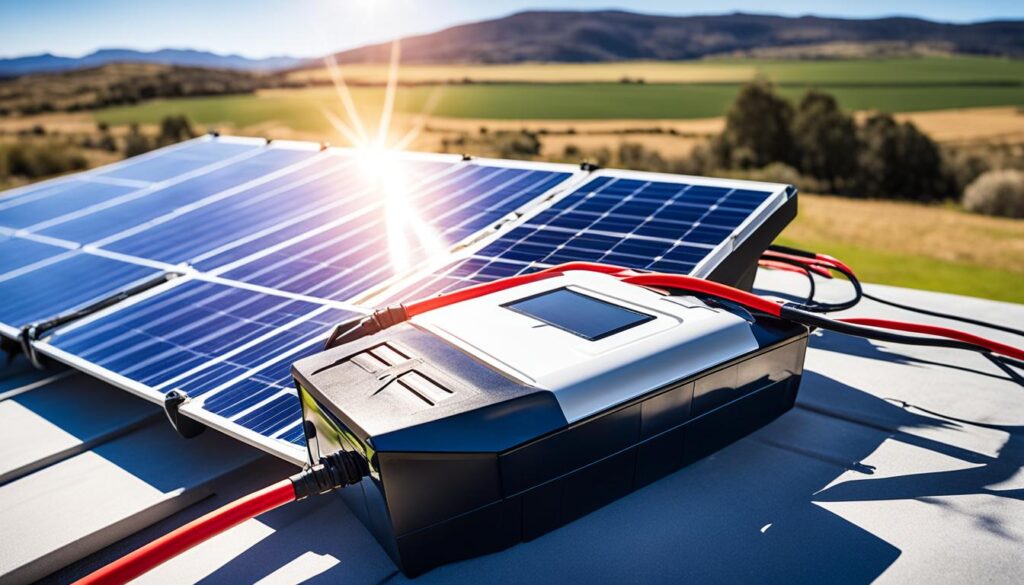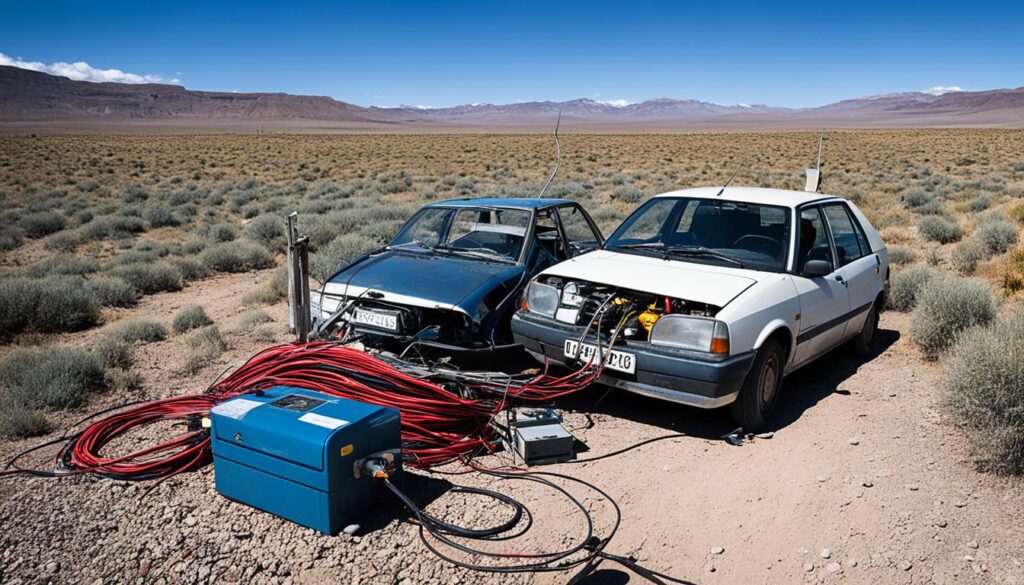Ever been stuck with a dead car battery and no charger around? It’s really annoying. But there’s hope. We’ll talk about some neat ways to get your battery working again without a charger.
- Charging a dead car battery without a charger is possible using alternative methods.
- Jump starting, push starting, and utilizing the alternator are some of the techniques you can use.
- Solar panels, DC-to-DC chargers, battery isolators, charging with another vehicle, and using a car jump starter are other options to consider.
- Each method has its own limitations and precautions to follow.
- Always prioritize using a battery charger when it’s available.
When your car battery dies without a charger nearby, it feels like you’re out of luck. But don’t lose hope yet. Many methods exist to bring your battery back to life and get you moving. Let’s explore how to charge your dead car battery without needing a charger.
Jump Starting
Jump starting is a way to recharge a dead car battery. It uses another vehicle’s battery to give energy to the dead one. This is very useful when you don’t have jumper cables.
“Jump starting a car without cables is a valuable skill to have in emergency situations. It can get you back on the road quickly without the need for additional equipment,” says John Brown, a professional mechanic with over 10 years of experience.
Here’s how to jump start a car without jumper cables:
- Make sure both cars are close enough for the jumper cables to connect.
- Turn off both vehicles.
- Find the positive and negative terminals on both batteries. The positive has a “+” sign, the negative a “-“.
- Attach the positive clamp to the dead battery’s positive terminal.
- Connect the negative clamp to a metal part on the dead car.
- Start the vehicle with the charged battery. Let it run a few minutes.
- Try to start the dead car. If it fails, wait and try again.
- Once the dead car starts, unhook the cables in reverse order.
Always be safe when jump starting. Wear protection and make sure cars are in park. Follow your vehicle’s instructions carefully.
Why Jump Start a Car Without Another Car?
Sometimes, another car isn’t around. Jump starting without cables can then save the day. It helps you get going again without needing a charger. This is very handy in remote places or emergencies.
Knowing how to jump start without cables is useful. Just follow the steps and be safe. You can bring a dead battery back to life without needing another car.
Push Starting
Push starting, or bump starting, helps to start a car with a dead battery. It uses the car’s momentum to start the engine. This means you can start your car without jumper cables or another car.
To push start your car, just follow these easy steps:
- Make sure the ignition is “on,” and push down on both the clutch and brake.
- Look for a flat road or a slight downhill slope to get moving.
- Have friends push the car from behind with the key in the ignition and gear in neutral.
- When you reach about 5-10 mph, quickly let go of the clutch and step on the gas.
- If you did it right, the engine will start. Be ready for the car to jerk suddenly.
- Keep the engine on for a bit to recharge the battery. Do not turn off the engine until you reach a place where you can charge the battery fully.
Remember, be careful when push starting. Make sure there are no people or cars around. Also, check that the car’s manual transmission works well to avoid problems.
If you can’t start the car this way, it’s best to get professional help or try another way to charge the battery.
| Pros | Cons | |
|---|---|---|
| Pros | No need for jumper cables or another car | Needs a flat or downhill surface for pushing |
| Cons | Can be hard work if the car is heavy | May not work for all cars or situations |

Push starting is good in a pinch when you don’t have a charger. But, it’s not a permanent fix. Always charge your battery and check for other problems to avoid trouble later.
Using the Alternator
One simple way to charge a dead car battery is by using the alternator. This part of your car turns mechanical energy into electrical energy while the engine runs. It powers the car’s electric systems and keeps the battery charged.
If your car’s battery is dead, the alternator can give it emergency power. Follow these steps to do it:
- Find the positive and negative terminals of the dead battery.
- Connect a jumper cable from the positive terminal of the dead battery to the positive of a charged battery in another car.
- Attach the other end of this cable to the positive terminal of your dead battery.
- Now, connect a cable from the negative terminal of the charged battery to your car’s engine block or a metal surface.
- Make sure all connections are secure, then start the engine of the car with the charged battery.
- Let the engine run for a few minutes. This helps the alternator charge the dead battery.
- After the dead battery gets some charge, try starting your car. If it starts, let the engine run to charge the battery more.
Keep in mind, using the alternator for charging is only a temporary fix. Make sure both cars are in Park or Neutral with engines off before connecting them. Always follow safety steps and look at your vehicle’s manual for detailed instructions.
Note: For this method, you need another car with a fully charged battery.
This trick with the alternator lets you give emergency power to a dead battery. Then you can get moving again.
Use a Solar Panel and Solar Charger
Solar panels and solar chargers are great for the environment. They help charge a car battery when you can’t use traditional chargers. With them, your car battery will always be ready, even in hard-to-reach places.
Choosing the right solar panel for your car is key. Make sure it meets the wattage and voltage your battery needs. Also, pick a panel that’s the right size and easy to move. This way, you can get the most sunlight.
A solar charge controller is necessary to connect the solar panel to your car battery. It makes sure the battery charges right without getting damaged. Connect the solar panel to the controller, and then the controller to the battery.
‘Harness the power of the sun to charge your car battery and keep it ready for your adventures.’ – Solar Enthusiast
Selecting the Right Solar Panel
When picking a solar panel, keep these in mind:
- Wattage: Make sure the panel can effectively charge your battery.
- Voltage: The panel’s voltage should match your battery’s for the best charge.
- Portability: It should be easy to carry and set up.
- Durability: Pick a panel that can handle the outdoors, including heat and rain.
Solar Battery Charger Recommendations
Here are top solar chargers for cars:
| Brand | Model | Wattage |
|---|---|---|
| Sunway Solar | Solar Battery Charger | 12W |
| POWISER | Solar Battery Charger | 7.5W |
| Renogy | Solar Battery Charger | 20W |
These chargers are known for their good performance and fit for car batteries. Think about their wattage and if they work with your battery. Make sure the charger includes all you need for setup.

Using a solar panel and charger lets you charge your car battery in a green way. Enjoy your trips without fearing battery issues.
Use a DC-to-DC Charger
If your car sits in a spot with poor sunlight and you need to charge its battery, think about using a DC-to-DC charger. This charger pulls energy from another battery. It then uses this energy to charge your car battery by increasing the voltage.
A DC-to-DC charger is handy when you can’t use solar power. It lets you charge your car battery from another battery, like a deep cycle or auxiliary one. This is great for vehicles used in off-roading or camping where you might have extra batteries.
Choosing the right DC-to-DC charger is crucial. Make sure it fits your car’s electrical system and battery specs. Aim for a charger made for cars that meets the voltage and current your battery needs.
| Advantages of Using a DC-to-DC Charger | Limitations of Using a DC-to-DC Charger |
|---|---|
|
|
Remember, a DC-to-DC charger shouldn’t replace regular charging and upkeep of your battery. Whenever possible, use a charger made for automotive use. This ensures your battery charges well and lasts longer.
For more on battery chargers, check out Wikipedia’s Battery Charger page.
“Using a DC-to-DC charger provides a convenient solution when solar charging is not feasible.”
Jump the Car and Use the Car’s Charging System
If your car battery dies, you can jump start it if you have jumper cables or a lithium jump starter. Once the car starts, its charging system will power up the battery. This is because the car’s alternator will begin charging the battery after the engine starts.
**Jump starting a car without cables** can be a solution when you don’t have a charger. You’ll need a vehicle with a working battery or a portable jump starter. First, connect the dead battery’s positive terminal to the charged battery’s positive terminal. Then, connect the charged battery’s negative terminal to a metal part on the dead car’s engine block. After starting the working car’s engine, let it run for a bit to charge the dead battery.
**Car battery emergency power up** might take longer this way compared to a normal charger. Plus, it might not fully charge the battery. There are important safety tips for jump starting a car without cables:
- Ensure both vehicles or the jump starter are turned off before connecting the cables.
- Always connect the positive cables first, then the negative ones.
- Make sure the cables are securely connected.
- Be careful not to let the cables’ ends touch each other or any metal.
- When the car starts, remove the cables in the opposite order you connected them.
Jump starting should be a temporary fix. It’s smart to test the battery later and replace it if needed.
Safety Tips for Jump Starting a Car Without Cables:
- Ensure both vehicles or the jump starter are turned off before connecting the cables.
- Always connect the positive cables first, followed by the negative cables.
- Double-check that the cables are properly connected and secure.
- Avoid allowing the positive and negative cables to touch each other or any metal surfaces.
- Once the car is started, remove the cables in reverse order: negative cables first, then positive cables.
| Method | Pros | Cons |
|---|---|---|
| Jump Starting | – Allows use of the car’s charging system – Can be done with jumper cables or a jump starter |
– Charging process may take longer – Battery may not fully recharge |
| Push Starting With Another Car | – Doesn’t rely on a charger or external power source – Can be done with manual transmission vehicles |
– Requires a flat or downhill slope – Incompatible with automatic transmission vehicles |
| Using the Alternator | – Utilizes the car’s existing charging system – Works when the engine is running |
– Limited charging speed – Relies on the car’s fuel to run the engine |
Use a Battery Isolator
A battery isolator lets you charge a second battery without a charger. It uses power from the primary battery’s alternator. Though not the most efficient, it’s good for some situations.
How Does a Battery Isolator Work?
A battery isolator charges multiple batteries from one alternator. It keeps the primary and secondary batteries’ circuits separate. This avoids draining the primary battery during charging.
With the engine on, the alternator powers up. The isolator then guides this power to the secondary battery. This ensures the secondary battery gets charged without affecting the primary one.
Installing a battery isolator usually needs a pro. This makes sure it works right and safely.
The Limitations of a Battery Isolator
Battery isolators are great for a secondary battery but have downsides:
- They work best if the primary battery is already full. A low primary battery means less charge for the secondary.
- The charge to the secondary battery is slower. This happens because the current is split between batteries.
- Some vehicles or systems might not work with a battery isolator. You might need extra parts or changes for it to fit.
Charge Battery By Putting It Into Another Vehicle
Sometimes, you can charge a car battery by using another vehicle’s battery slot. But, this trick only works if the batteries match and are compatible.
To safely charge your car battery in another vehicle, be careful and follow safety steps.
- Make sure the batteries have the same voltage rating to avoid damage or explosions.
- Ensure the battery terminals are clean for a strong electrical connection.
- With cars off, use a jumper cable to connect the positive terminals of both batteries.
- Then, link the charged vehicle’s negative terminal to a metal surface on the other car.
- Start the charged car and wait a few minutes for the charge to transfer.
- If the other car starts, the charge has moved successfully.
Remember, this method might help in a pinch but isn’t a long-term fix. Always charge the battery properly with a charger to keep it working well.
Cautionary Measures:
Don’t let the jumper cables touch metal or each other during charging. This prevents sparks and dangers.
Always use the manual’s instructions for handling batteries and jumper cables safely.
Make sure both cars are parked, in neutral, and with parking brakes on before you start.
If unsure about this process, better to ask a professional or skilled mechanic for help.
These safety tips and guidelines help you charge a battery using another vehicle. It’s a handy solution when needed.
| Advantages | Disadvantages |
|---|---|
| Can provide a temporary solution in emergency situations | May not be compatible with all battery types |
| Does not require a separate charger | Transferring batteries can be cumbersome and time-consuming |
| Accessible option when no charger is available | Charging capability depends on the donor vehicle’s battery health |
Use a Car Jump Starter
A car jump starter is a life-saving tool when your car battery dies. With no charger around, it can get your car running quickly. But, how does it work and what safety steps should you follow?
Understanding how a car jump starter works is simple. It has a rechargeable battery and cables. You connect the positive (red) and negative (black) ends to your car’s battery. This gives your dead battery the power it needs to start your car.
Using a jump starter is easy. Just follow these steps:
- Position your vehicles: Make sure the jump starter is near the battery. Both cars should be off.
- Connect the jumper cables: First, attach the positive (red) cable to the dead battery’s positive terminal. Then, connect the negative (black) cable to a metal surface or the battery’s negative terminal. Don’t connect it to the jump starter directly.
- Start the engine: Start the car with the jump starter. Let the engine run for a bit to charge the dead battery.
- Remove the cables: First remove the negative (black) clamp, then the positive (red) clamp. Make sure the clamps don’t touch each other or any metal.
It’s important to be careful when using a jump starter. Keep these tips in mind:
- Read the instructions: Know how to use your specific model.
- Check for damage: Don’t use the jump starter if it’s damaged.
- Ensure compatibility: Make sure it works with your car’s battery and engine size.
- Follow correct polarity: Always match the red clamp to the positive terminal and the black to the negative.
- Avoid sparks: Keep the clamps separate to prevent sparks.
- Charge the jump starter: Keep it charged so it’s ready when you need it.
Following these steps and tips will help you use a jump starter safely and effectively. Keep one in your car’s emergency kit. You’ll be ready to get going again, even without a charger.
Conclusion
A battery charger is best for charging a car battery. Yet, we’ve covered alternative ways like jump starting and push starting. We also talked about using alternators, solar panels, DC-to-DC chargers, and battery isolators. Plus, charging with another vehicle and using a car jump starter were mentioned.
Each method has its own rules and safety tips. It’s crucial to know and follow these guidelines. In times when you have no charger, these alternatives can help get your battery working.
Always choose a charger when you can. It’s the safest and most effective way to charge your battery. But, knowing these other methods is handy for emergencies on the road.




